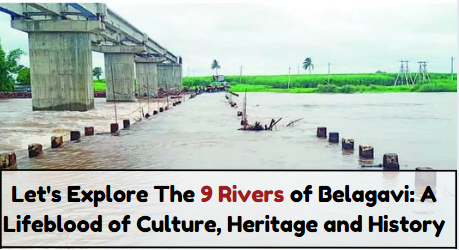
Belagavi district, also known as the Belgaum District, is the in Southwest Indian state of Karnataka. It is a city brimming with historical places, nestling with well-cultured historical places, cultural diversity, and scenic delights, which promises an enchanting and mesmerizing experience for visitors eager to delve into the rich heritage and prominent rivers of Belagavi.
LIST OF THE RIVERS IN BELAGAVI
- MARKANDEYA RIVER
Markandeya is a river of southern India, which rises in the Bailur in Khanapur Taluk of Belagavi district, Karnataka state.
The Markandeya River enters Belagavi Taluk on the southern side and flows towards the western side of Belagavi city. The river flows at a distance of 66 kilometers (41 miles) in Belagavi District which forms a mesmerizing Godchinamalaki Falls before joining the Ghataprabha River.
At present, the Markandeya is filled with silt and bushes have grown along the banks. The Government of Karnataka is constructing an irrigation dam across the Markandeya River at Shirur, near Hukkeri.
2. THE GHATAPRABHA RIVER:
The Ghataprabha River in India is an important right-bank tributary of the Krishna River and flows eastward for a distance of 283 kilometers before its confluence with the Krishna River at Chikksangam.
The river is crossed by a suspension bridge near the Gokak Falls. The Markandeya River and Hiranyakeshi River are the tributaries of the Ghataprabha River. The bridge was constructed in the late 1800s to early 1900s. Hidkal Dam with a capacity of 51 Tmcft is built across the river in Belagavi district.
3. KRISHNA RIVER:
The Krishna River is the 3rd longest river in India, after the Ganga and Godavari. It is a major source of water for the nearby villages.
The Krishna River basin is endowed with a rich source of mineral deposits such as oil and gas, coal, iron, limestone, dolomite, gold, granite, laterite, uranium, diamonds, and many more.
4. MALAPRABHA RIVER:
The Malaprabha River valley in Northern Karnataka is one of the most historically significant sites in the country. It is a tributary of the Krishna River and flows through the state of Karnataka in India. The river joins the Krishna River at Kudalasangama in the Bagalkot district.
Malaprabha River originates in the Sahyadri mountains at an elevation of 792.4 meters (2,600 ft) at Kanakumbi village 16-kilometer (9.9 miles) west of Jamboti village, Khanapur taluka, Belgaum District, Karnataka. At the origin of the Malaprabha river, there is an ancient temple dedicated to Shree Mauli Devi. The temple is in R.S. No. 127 of Kankumbi.
5. MAHADAYI (MANDOVI) RIVER:
The Mandovi River is popularly known as “The Lifeline of North Karnataka’s drought-hit region”. Mahadayi River rises in the Western Ghats, from the Bhimgad Wildlife Sanctuary in Khanapur Taluk of the Belagavi district, Karnataka State.
The Kalasa, Surla, and Banduri rivers are the important tributaries of the Mandayi River. The river is important for the irrigation and drinking water of the areas in the Belagavi, Dharwad, and Gadag districts.
6. DUDHGANGA RIVER:
The Dudhganga River is a right-bank tributary river of the Krishna in Western India. The Dudhganga River is an essential tributary of the Jhelum River, which is named for its milky white waters, which resemble the color of milk. In current years, the river has been seen in a transformation in its tourism trends.
6. TUNGABHADRA RIVER:
The Tungabhadra River is a significant peninsular river in the Southern River. The Tungabhadra River is a major tributary of the Krishna River. The river is chiefly influenced by the Southwest Monsoon. The major tributaries of the Tungabhadra River are the Varada River and Hagari (Vedathy) River.
The river runs for 382 km in Karnataka, forms the boundary between Karnataka and Andhra Pradesh for 58 km, and runs for the next 91 km in Andhra Pradesh. The river has several dams and reservoirs built on it, including the Tunga Anicut Dam, the Bhadra Dam, the Hemavathy Dam, and the Tungabhadra Dam. The river Tungabhadra serves as a source of drinking water and irrigation for many other cities and towns.
In the epic Ramayana, the Tungabhadra River was called the Pampa River. The city of Hampi, the capital of the Vijayanagara Empire is located on the banks of the river. In 1525 AD and 1527 AD, King Krishnadevaraya constructed flood protection walls along all the rivers on the river banks.
7. THE BELAGAVI NALA:
Belagavi Nala is a river of southern India in Belagavi city of Karnataka state. It is a 38-kilometre-long network of drains and covers an area of about 169 acres.
Belagavi Nala is a tributary of Ballari Nala, which rises at Laxmi Tekdi in Belgaum city and covers Laxminagar in the outskirts of Belagavi district in Karnataka. The river flows through Camp, Station Road, Shastri Nagar, Shivaji Garden, and Vishwakarmanagar.
In the surroundings, the visitors can explore other natural wonders which include; The Krishna River, The Markandeya River, The Ghataprabha River, and The Godchinamalaki River.
However, the rivers in Belagavi contribute significantly to the district’s irrigation, drinking water for local people, and fisheries, often by supporting large populations by enabling agricultural facilities and holding significant cultural and religious value depending on the region.
FOR MORE UPDATES OF BELAGAVI VISIT- https://nammabelagavinews.com/